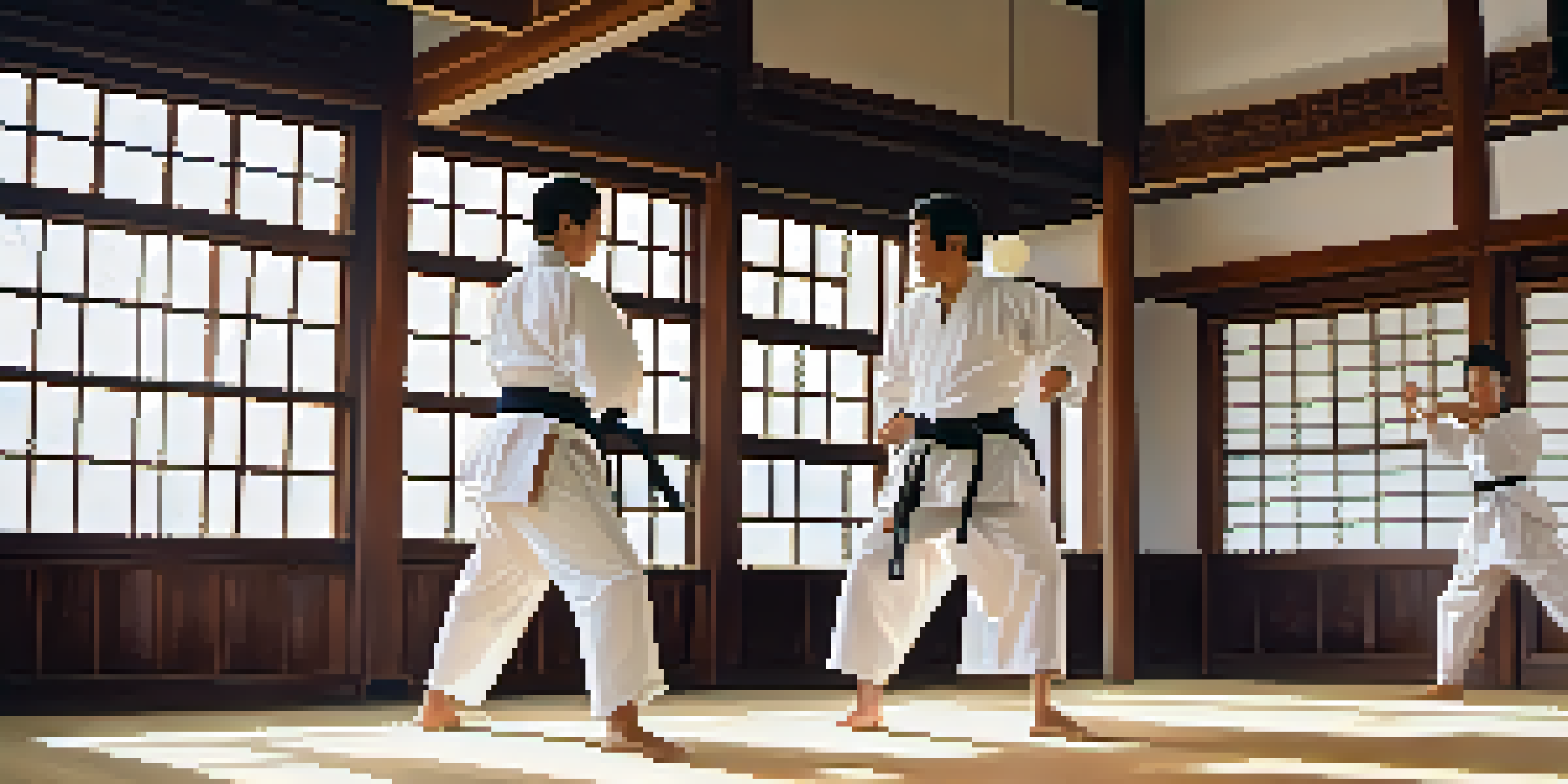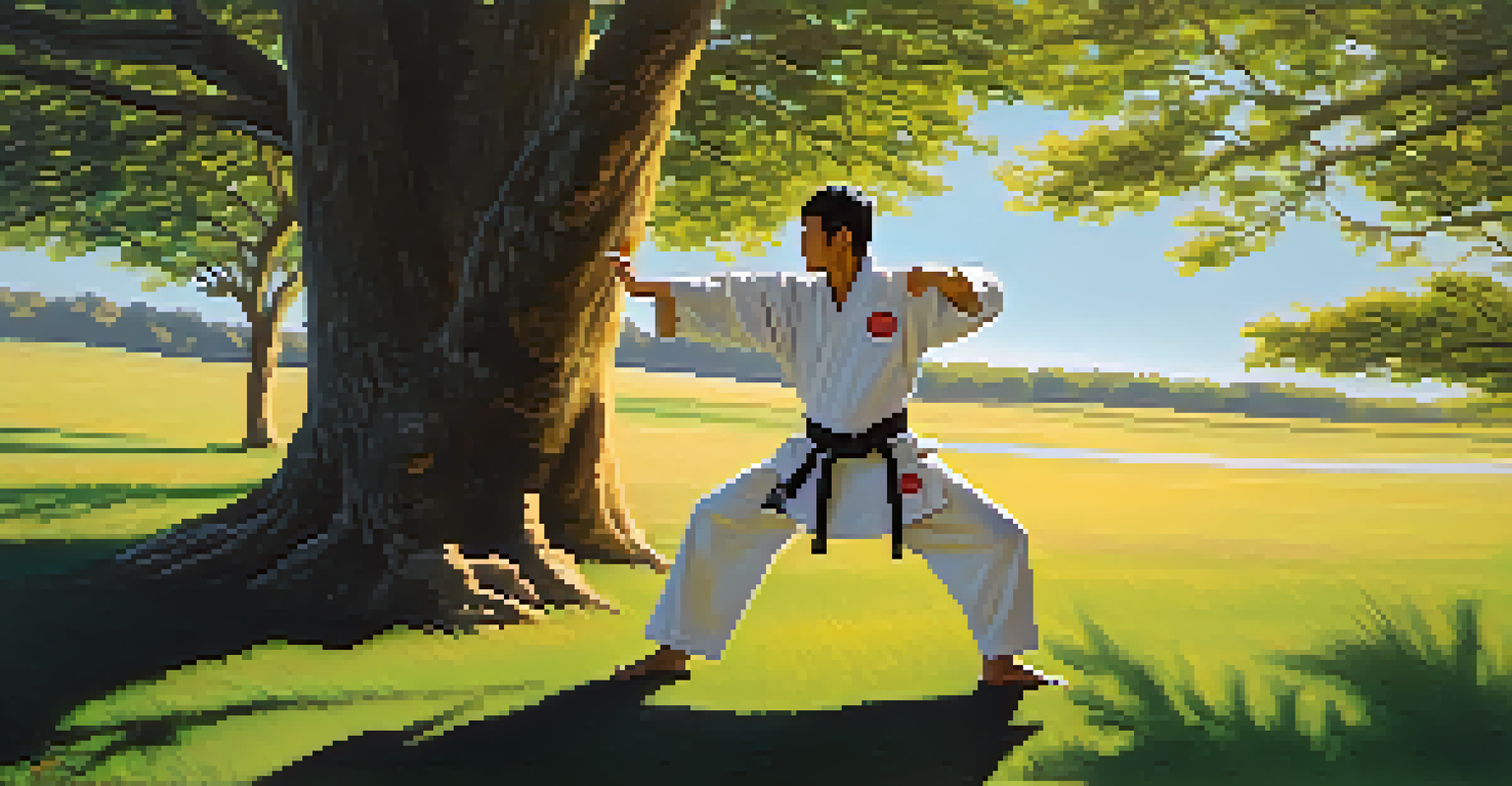Injury Prevention: Scientific Approaches for Martial Artists

Understanding Common Injuries in Martial Arts
Martial artists face a variety of injuries, often stemming from repetitive movements, high-impact techniques, and sparring. Common issues include sprains, strains, and fractures, which can sideline practitioners for extended periods. Understanding these injuries is crucial for any martial artist looking to maintain longevity in their practice.
An ounce of prevention is worth a pound of cure.
For instance, a sprained ankle can arise from improper footwork or landing techniques during a kick. Identifying the most frequent injuries in your discipline can help tailor prevention strategies that are effective and relevant. This awareness is the first step towards a safer training environment.
By analyzing injury statistics and common patterns, martial artists can better prepare themselves and adopt practices that minimize risk. This proactive approach not only enhances performance but also builds confidence in one’s abilities.
The Role of Warm-Ups in Injury Prevention
Warm-ups are often overlooked, but they play a crucial role in preparing the body for intense physical activity. By gradually increasing blood flow to muscles and enhancing flexibility, warm-ups can significantly reduce the risk of injuries. Think of warm-ups as the equivalent of oiling a machine before operating it; it just works better.

A proper warm-up typically includes dynamic stretches and movements that mimic the techniques you’ll be practicing. For example, light shadowboxing or mobility exercises can efficiently get your body ready for action. This not only helps prevent injuries but also improves overall performance.
Injury Awareness Enhances Safety
Understanding common injuries in martial arts allows practitioners to implement effective prevention strategies.
Incorporating a structured warm-up routine into your training can create a habit that fosters safety and longevity. Remember, taking just a few minutes to warm up can save you weeks or even months of recovery time.
Strength Training: A Key Component of Injury Prevention
Strength training is not just for bodybuilders; it's a fundamental aspect of injury prevention for martial artists. By building muscle strength, you enhance your body’s ability to withstand the physical demands of training and competition. Strong muscles support joints and reduce the likelihood of strains and sprains.
The body achieves what the mind believes.
For instance, incorporating exercises like squats, lunges, and core workouts can improve your stability and power in various martial arts techniques. These exercises help create a balanced physique that can handle the stresses of striking and grappling. Think of strength training as the foundation of a house; without it, everything else is at risk.
Moreover, strength training should be tailored to individual needs, considering factors like age, skill level, and specific martial arts style. A personalized approach ensures that you’re addressing your unique vulnerabilities, making it a vital part of a comprehensive injury prevention strategy.
Flexibility Training: Enhancing Mobility and Reducing Injury Risk
Flexibility training is essential for martial artists, as it improves range of motion and helps prevent injuries. Tight muscles can lead to imbalances and increase the risk of strains, especially in high-impact disciplines. Think of flexibility as the oil that keeps your joints moving smoothly during practice.
Incorporating static and dynamic stretching into your routine can enhance flexibility over time. For example, post-training stretching not only aids recovery but also elongates muscles, which can prevent injuries during future sessions. A simple routine after your workouts can make a big difference.
Warm-Ups Are Key to Prevention
Incorporating proper warm-up routines prepares the body for training and significantly reduces injury risk.
Moreover, yoga and other mobility-focused practices can complement traditional training styles. They encourage relaxation and mindfulness, which can also reduce the mental stress that sometimes leads to injuries caused by overexertion or improper technique.
Proper Technique: The Foundation of Injury Prevention
Proper technique is the cornerstone of effective injury prevention in martial arts. Learning the correct way to execute strikes, falls, and grappling maneuvers helps minimize strain on the body. When you focus on form, you’re not just practicing skills; you’re actively protecting yourself from injuries.
For instance, a well-executed kick distributes force evenly, while a poorly executed one can lead to knee injuries. Regular feedback from instructors and peers can help refine your technique, making it safer and more efficient. Remember, even the smallest adjustments can lead to significant improvements in safety.
Additionally, drilling techniques slowly before increasing speed can help instill muscle memory and ensure that movements become second nature. This gradual progression supports injury prevention, especially for beginners who are still mastering their skills.
The Importance of Recovery in Injury Prevention
Recovery is often underestimated, yet it is a crucial element in injury prevention. Allowing your body time to heal and rebuild is essential after rigorous training sessions. Think of recovery as the time your body needs to recharge, similar to how batteries need to be recharged to function optimally.
Incorporating rest days, proper sleep, and active recovery methods like light stretching or low-intensity workouts can facilitate this process. Ignoring recovery can lead to overuse injuries, which are often harder to treat and prolong your training interruptions. Listen to your body; it knows when it needs a break.
Nutrition Supports Recovery and Health
A balanced diet fuels training, aids recovery, and plays a vital role in preventing injuries for martial artists.
Moreover, techniques such as foam rolling and massage can aid recovery by improving circulation and reducing muscle tension. By prioritizing recovery, you not only prevent injuries but also enhance your overall performance and enjoyment of martial arts.
Nutrition's Role in Injury Prevention for Martial Artists
Nutrition plays a vital role in supporting an athlete's body, especially in martial arts. A balanced diet rich in vitamins, minerals, and macronutrients fuels your training and aids recovery. Think of food as the high-quality fuel that keeps your engine running smoothly; without it, performance and recovery can suffer.
In particular, proteins are essential for muscle repair, while carbohydrates provide the energy needed for intense training sessions. Don't forget about hydration, as proper fluid intake is critical for maintaining muscle function and preventing cramps. A well-rounded diet helps ensure your body is equipped to handle the physical challenges of martial arts.

Furthermore, certain foods can have anti-inflammatory properties, which can aid in recovery and reduce injury risk. Incorporating fruits, vegetables, and healthy fats into your meals can provide the nutrients necessary for optimal performance and injury prevention.
The Mental Aspect of Injury Prevention in Martial Arts
While physical training is essential, the mental aspect of injury prevention is equally important. Developing a strong mindset helps martial artists stay focused and aware of their bodies during training. Mental preparedness can prevent injuries caused by distraction or overexertion, both of which can impair judgment.
Practicing mindfulness and visualization techniques can enhance concentration and help you recognize your limits. For example, visualizing successful techniques can build confidence while also reinforcing safe practices. This mental conditioning not only improves performance but also fosters a proactive approach to safety.
Moreover, fostering a positive training environment encourages open communication about injuries and concerns. When martial artists feel comfortable discussing their physical and mental states, it leads to better support and injury prevention strategies within the community.